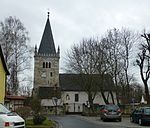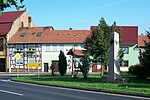St. Mary's Church, Mühlhausen
14th-century churches in GermanyBuildings and structures in Unstrut-Hainich-KreisGothic hall churches in GermanyLutheran churches converted from Roman CatholicismLutheran churches in Thuringia ... and 3 more
Museums in ThuringiaMühlhausenUse British English from June 2018

St. Mary's Church (German: Marienkirche) in the town of Mühlhausen, central Germany, is the second-largest church building in Thuringia after Erfurt Cathedral. It was constructed mainly during the 14th century in the Gothic style. The church's 86.7-metre-high (284 ft 5 in) central spire, built in 1898 to 1903, is the highest in the state and forms a significant feature of the town's skyline. St. Mary's was a site of events relating to the German Peasants' War around 1525, as the revolutionary leader Thomas Müntzer was active as a pastor at the church. The Sauer organ, built in 1891, is considered the largest surviving 19th-century organ in Thuringia.
Excerpt from the Wikipedia article St. Mary's Church, Mühlhausen (License: CC BY-SA 3.0, Authors, Images).St. Mary's Church, Mühlhausen
Bei der Marienkirche,
Geographical coordinates (GPS) Address External links Nearby Places Show on map
Geographical coordinates (GPS)
| Latitude | Longitude |
|---|---|
| N 51.210277777778 ° | E 10.455 ° |
Address
Marienkirche
Bei der Marienkirche
99974
Thuringia, Germany
Open on Google Maps











